Matching-to-Sample Task Training of a Killer Whale (Orcinus orca)
Abstract
Simple Summary
Abstract
1. Introduction
2. Materials and Methods
2.1. Subject
2.2. Apparatus
2.3. Procedure
3. Training
3.1. The Teaching of the Matching-to-Sample Rule with Three Real Objects
3.2. The Addition of New Real Objects and a Generalization Test
3.3. The Addition of Geometric Patterns
3.4. Changing the Stimuli from Real Objects to Photographs
3.5. Changing the Stimuli from Photographs to Monitor Presentation
3.6. The Generalization Test in the Monitor Presentation Stage
4. Experiment
4.1. Introduction
4.2. Result
4.3. Discussion
5. General Discussion
6. Conclusions
Author Contributions
Funding
Institutional Review Board Statement
Informed Consent Statement
Data Availability Statement
Acknowledgments
Conflicts of Interest
References
- Egelkamp, C.L.; Ross, S.R. A review of zoo-based cognitive research using touchscreen interfaces. Zoo Biol. 2019, 38, 220–235. [Google Scholar] [CrossRef]
- Matsuno, T.; Kawai, N.; Matsuzawa, T. Color classification by chimpanzees (Pan troglodytes) in a matching-to-sample task. Behav. Brain Res. 2004, 148, 157–165. [Google Scholar] [CrossRef]
- Martin, C.F.; Biro, D.; Matsuzawa, T. Chimpanzees’ use of conspecific cues in matching-to-sample tasks: Public information use in a fully automated testing environment. Anim. Cogn. 2011, 14, 893–902. [Google Scholar] [CrossRef] [PubMed]
- Altschul, D.M.; Wallace, E.K.; Sonnweber, R.; Tomonaga, M.; Weiss, A. Chimpanzee intellect: Personality, performance and motivation with touchscreen tasks. R. Soc. Open Sci. 2017, 4, 170169. [Google Scholar] [CrossRef] [PubMed]
- Kret, M.E.; Jaasma, L.; Bionda, T.; Wijnen, J.G. Bonobos (Pan paniscus) show an attentional bias toward conspecifics’ emotions. Proc. Natl. Acad. Sci. USA 2016, 113, 3761–3766. [Google Scholar] [CrossRef] [PubMed]
- Kawaguchi, Y.; Kano, F.; Tomonaga, M. Chimpanzees, but not bonobos, attend more to infant than adult conspecifics. Anim. Behav. 2019, 154, 171–181. [Google Scholar] [CrossRef]
- Martin, C.F.; Shumaker, R.W. Orangutan strategies for solving a visuospatial memory task. Am. J. Primatol. 2022, 84, e23367. [Google Scholar] [CrossRef]
- Diamond, R.F.; Stoinski, T.S.; Mickelberg, J.L.; Basile, B.M.; Gazes, R.P.; Templer, V.L.; Hampton, R.R. Similar stimulus features control visual classification in orangutans and rhesus monkeys. J. Exp. Anal. Behav. 2016, 105, 100–110. [Google Scholar] [CrossRef] [PubMed]
- Vonk, J. Quantity matching by an orangutan (Pongo abelii). Anim. Cogn. 2014, 17, 297–306. [Google Scholar] [CrossRef] [PubMed]
- Vonk, J. Matching based on biological categories in Orangutans (Pongo abelii) and a Gorilla (Gorilla gorilla gorilla). PeerJ 2013, 1, e158. [Google Scholar] [CrossRef]
- McGuire, M.C.; Vonk, J. Gorillas (Gorilla gorilla gorilla) fail to learn abstract cues of differential outcomes in a novel cognitive bias test. Anim. Behav. Cogn. 2018, 5, 103–117. [Google Scholar] [CrossRef][Green Version]
- Munir, G.M.; Nealen, P.M. Preliminary assessment of siamang (Symphalangus syndactylus) cognition using digital cognition testing software and touchscreen technology. Anim. Behav. Cogn. 2023, 10, 14–39. [Google Scholar] [CrossRef]
- Leeds, A.; Lukas, K.E. Experimentally evaluating the function of self-directed behaviour in two adult mandrills (Mandrillus sphinx). Anim. Welf. 2018, 27, 81–86. [Google Scholar] [CrossRef]
- Leighty, K.A.; Maloney, M.A.; Kuhar, C.W.; Phillips, R.S.; Wild, J.M.; Chaplin, M.S.; Betting, T.L. Use of a touchscreen-mediated testing system with mandrill monkeys. Int. J. Comp. Psychol. 2011, 24, 60–75. [Google Scholar] [CrossRef]
- Parr, L.A.; Heintz, M. Facial expression recognition in rhesus monkeys, Macaca mulatta. Anim. Behav. 2009, 77, 1507–1513. [Google Scholar] [CrossRef]
- Shibasaki, M.; Kawai, N. Rapid detection of snakes by Japanese monkeys (Macaca fuscata): An evolutionarily predisposed visual system. J. Comp. Psychol. 2009, 123, 131. [Google Scholar] [CrossRef]
- Zeagler, C.; Gilliland, S.; Freil, L.; Starner, T.; Jackson, M. Going to the dogs: Towards an interactive touchscreen interface for working dogs. In Proceedings of the 27th Annual ACM Symposium on User Interface Software and Technology, Honolulu, HI, USA, 5–8 October 2014. [Google Scholar]
- Perdue, B.M. The effect of computerized testing on sun bear behavior and enrichment preferences. Behav. Sci. 2016, 6, 19. [Google Scholar] [CrossRef]
- Bussey, T.J.; Padain, T.L.; Skillings, E.A.; Winters, B.D.; Morton, A.J.; Saksida, L.M. The touchscreen cognitive testing method for rodents: How to get the best out of your rat. Learn. Mem. 2008, 15, 516. [Google Scholar] [CrossRef] [PubMed]
- Guigueno, M.F.; MacDougall-Shackleton, S.A.; Sherry, D.F. Sex differences in spatial memory in brown-headed cowbirds: Males outperform females on a touchscreen task. PLoS ONE 2015, 10, e0128302. [Google Scholar] [CrossRef] [PubMed]
- Huber, L.; Heise, N.; Zeman, C.; Palmers, C. The ALDB box: Automatic testing of cognitive performance in groups of aviary-housed pigeons. Behav. Res. Methods 2015, 47, 162–171. [Google Scholar] [CrossRef] [PubMed]
- o’Hara, M.; Mioduszewska, B.; von Bayern, A.; Auersperg, A.; Bugnyar, T.; Wilkinson, A.; Huber, L.; Gajdon, G.K. The temporal dependence of exploration on neotic style in birds. Sci. Rep. 2017, 7, 4742. [Google Scholar] [CrossRef] [PubMed]
- Slabbekoorn, H.; Bouton, N.; van Opzeeland, I.; Coers, A.; ten Cate, C.; Popper, A.N. A noisy spring: The impact of globally rising underwater sound levels on fish. Trends Ecol. Evol. 2010, 25, 419–427. [Google Scholar] [CrossRef] [PubMed]
- Davis, R.W.; Davis, R.W. Sensory Systems. In Marine Mammals: Adaptations for an Aquatic Life; Springer International Publishing: Berlin/Heidelberg, Germany, 2019; pp. 177–217. [Google Scholar]
- Nummela, S.; Yamato, M. Hearing. In Encyclopedia of Marine Mammals, 3rd ed.; Wursig, B., Thewissen, J.G.M., Kovacs, K.M., Eds.; Academic Press: Cambridge, MA, USA, 2018; pp. 462–470. [Google Scholar]
- Au, W.W. Echolocation. In Encyclopedia of Marine Mammals, 3rd ed.; Wursig, B., Thewissen, J.G.M., Kovacs, K.M., Eds.; Academic Press: Cambridge, MA, USA, 2018; pp. 289–299. [Google Scholar]
- Mass, A.M.; Supin, A.Y. Vision. In Encyclopedia of Marine Mammals, 3rd ed.; Wursig, B., Thewissen, J.G.M., Kovacs, K.M., Eds.; Academic Press: Cambridge, MA, USA, 2018; pp. 1035–1044. [Google Scholar]
- Griebel, U.; Peichl, L. Colour vision in aquatic mammals-facts and open questions. Aquat. Mamm. 2003, 29, 18–30. [Google Scholar] [CrossRef]
- Dudzinski, K.M. Communication and Behavior in the Atlantic Spotted Dolphins (Stenella frontalis): Relationships between Vocal and Behavioral Activities; A&M University: College Station, TX, USA, 1996. [Google Scholar]
- Connor, R.C.; Wells, R.S.; Mann, J.A.N.E.T.; Read, A.J. The bottlenose dolphin. In Cetacean Societies: Field Studies of Dolphins and Whales; Mann, J., Ed.; University of Chicago Press: Chicago, IL, USA, 2000; pp. 91–125. [Google Scholar]
- Tyack, P.L. Functional aspects of cetacean communication. In Cetacean Societies: Field Studies of Dolphins and Whales; Mann, J., Ed.; University of Chicago Press: Chicago, IL, USA, 2000; pp. 270–307. [Google Scholar]
- Pack, A.A.; Herman, L.M. Sensory integration in the bottlenosed dolphin: Immediate recognition of complex shapes across the senses of echolocation and vision. J. Acoust. Soc. Am. 1995, 98, 722–733. [Google Scholar] [CrossRef] [PubMed]
- Herman, L.M.; Pack, A.A.; Hoffmann-Kuhnt, M. Seeing through sound: Dolphins (Tursiops truncatus) perceive the spatial structure of objects through echolocation. J. Comp. Psychol. 1998, 112, 292. [Google Scholar] [CrossRef]
- Pack, A.A.; Herman, L.M.; Hoffmann-Kuhnt, M.; Branstetter, B.K. The object behind the echo: Dolphins (Tursiops truncatus) perceive object shape globally through echolocation. Behav. Process. 2002, 58, 1–26. [Google Scholar] [CrossRef]
- Mercado, E., III; Killebrew, D.A.; Pack, A.A.; Mácha, I.V.; Herman, L.M. Generalization of ‘same–different’ classification abilities in bottlenosed dolphins. Behav. Process. 2000, 50, 79–94. [Google Scholar] [CrossRef]
- Tomonaga, M.; Uwano, Y.; Saito, T. How dolphins see the world: A comparison with chimpanzees and humans. Sci. Rep. 2014, 4, 3717. [Google Scholar] [CrossRef]
- Herman, L.M. What laboratory research has told us about dolphin cognition. Int. J. Comp. Psychol. 2010, 23, 310–330. [Google Scholar] [CrossRef]
- Liu, Y.; Cotton, J.A.; Shen, B.; Han, X.; Rossiter, S.J.; Zhang, S. Convergent sequence evolution between echolocating bats and dolphins. Curr. Biol. 2010, 20, R53–R54. [Google Scholar] [CrossRef] [PubMed]
- Finneran, J.J.; Houser, D.S.; Moore, P.W.; Branstetter, B.K.; Trickey, J.S.; Ridgway, S.H. A method to enable a bottlenose dolphin (Tursiops truncatus) to echolocate while out of water. J. Acoust. Soc. Am. 2010, 128, 1483–1489. [Google Scholar] [CrossRef] [PubMed]
- Starkhammar, J.; Amundin, M.; Olsén, H.; Almqvist, M.; Lindström, K.; Persson, H.W. Acoustic touch screen for dolphins, first application of ELVIS-an echo-location visualization and interface system. In Proceedings of the 4th International Conference on Bio-Acoustics, Loughborough, UK, 10–12 April 2007; No. Part 3. Curran Associates, Inc.: New York, NY, USA, 2007; Volume 29, pp. 63–68. [Google Scholar]
- Mauck, B.; Dehnhardt, G. Mental rotation in a California sea lion (Zalophus californianus). J. Exp. Biol. 1997, 200, 1309–1316. [Google Scholar] [CrossRef]
- Matrai, E.; Hoffmann-Kuhnt, M.; Kwok, S.T. Lateralization in accuracy, reaction time and behavioral processes in a visual discrimination task in an Indo-Pacific bottlenose dolphin (Tursiops aduncus). Behav. Process. 2019, 162, 112–118. [Google Scholar] [CrossRef] [PubMed]
- Delfour, F.; Marten, K. Inter-modal learning task in bottlenosed dolphins (Tursiops truncatus): A preliminary study showed that social factors might influence learning strategies. Acta Ethologica 2005, 8, 57–64. [Google Scholar] [CrossRef]
- Delfour, F.; Marten, K. Lateralized visual behavior in bottlenose dolphins (Tursiops truncatus) performing audio–visual tasks: The right visual field advantage. Behav. Process. 2006, 71, 41–50. [Google Scholar] [CrossRef]
- Amundin, M.; Starkhammar, J.; Evander, M.; Almqvist, M.; Lindström, K.; Persson, H.W. An echolocation visualization and interface system for dolphin research. J. Acoust. Soc. Am. 2008, 123, 1188–1194. [Google Scholar] [CrossRef]
- Ford, J.K. Killer Whale: Orcinus orca. In Encyclopedia of Marine Mammals, 3rd ed.; Wursig, B., Thewissen, J.G.M., Kovacs, K.M., Eds.; Academic Press: Cambridge, MA, USA, 2018; pp. 531–537. [Google Scholar]
- Baird, R.W. The killer whale. In Cetacean Societies: Field Studies of Dolphins and Whales; Mann, J., Ed.; University of Chicago Press: Chicago, IL, USA, 2000; pp. 127–153. [Google Scholar]
- Møhl, B. Auditory sensitivity of the common seal in air and water. J. Audit. Res. 1968, 8, 27–38. [Google Scholar]
- Andersen, S. Auditory sensitivity of the harbour porpoise, Phocoena phocoena. Investig. Cetacea 1970, 2, 255–259. [Google Scholar]
- Terhune, J.M. Detection thresholds of a harbour seal to repeated underwater high-frequency, short-duration sinusoidal pulses. Can. J. Zool. 1988, 66, 1578–1582. [Google Scholar] [CrossRef]
- Barrett-Lennard, L.G.; Ford, J.K.; Heise, K.A. The mixed blessing of echolocation: Differences in sonar use by fish-eating and mammal-eating killer whales. Anim. Behav. 1996, 51, 553–565. [Google Scholar] [CrossRef]
- Deecke, V.B.; Ford, J.K.; Slater, P.J. The vocal behaviour of mammal-eating killer whales: Communicating with costly calls. Anim. Behav. 2005, 69, 395–405. [Google Scholar] [CrossRef]
- Baird, R.W. Foraging Behaviour and Ecology of Transient Killer Whales (Orcinus orca). Ph.D. Thesis, Simon Fraser University, Burnaby, BC, Canada, 8 August 1994. [Google Scholar]
- Baird, R.W.; Dill, L.M.; Hanson, M.B. Diving behaviour of killer whales. In Proceedings of the World Marine Mammal Science Conference, Monte Carlo, Monaco, 20–25 January 1998. [Google Scholar]
- Visser, I.; Smith, T.; Bullock, I.; Green, G.; Carlsson, O.L.; Imberti, S. Antarctic peninsula killer whales (Orcinus orca) hunt seals and a penguin on floating ice. Mar. Mammal Sci. 2008, 24, 225–234. [Google Scholar] [CrossRef]
- Lohmann, A.; Delius, J.D.; Hollard, V.D.; Friesel, M.F. Discrimination of shape reflections and shape orientations by Columba livia. J. Comp. Psychol. 1988, 102, 3. [Google Scholar] [CrossRef] [PubMed]
- Todrin, D.C.; Blough, D.S. The discrimination of mirror-image forms by pigeons. Percept. Psychophys. 1983, 34, 397–402. [Google Scholar] [CrossRef]
- Brown, J.V.; Ettlinger, G. Intermanual transfer of mirror-image discrimination by monkeys. Q. J. Exp. Psychol. Sect. B 1983, 35, 119–124. [Google Scholar] [CrossRef]
- Sanford, C.G.; Ward, J.P. Mirror image discrimination and hand preference in the bushbaby (Galago senegalensis). Psychol. Rec. 1986, 36, 439–449. [Google Scholar] [CrossRef]
- Nissen, H.W.; McCulloch, T.L. Equated and non-equated stimulus situations in discrimination learning by chimpanzees. I. Comparison with unlimited response. J. Comp. Psychol. 1937, 23, 165. [Google Scholar] [CrossRef]
- Winship, K.A.; Ramos, A.; Xitco, M.J., Jr. The introduction of a novel computerized apparatus to California sea lions (Zalophus californianus). Aquat. Mamm. 2023, 49, 73–86. [Google Scholar] [CrossRef]
- Bloomsmith, M.A.; Alford, P.L.; Maple, T.L. Successful feeding enrichment for captive chimpanzees. Am. J. Primatol. 1988, 16, 155–164. [Google Scholar] [CrossRef]
- Celli, M.L.; Tomonaga, M.; Udono, T.; Teramoto, M.; Nagano, K. Tool use task as environmental enrichment for captive chimpanzees. Appl. Anim. Behav. Sci. 2003, 81, 171–182. [Google Scholar] [CrossRef]
- Hopper, L.M.; Shender, M.A.; Ross, S.R. Behavioral research as physical enrichment for captive chimpanzees. Zoo Biol. 2016, 35, 293–297. [Google Scholar] [CrossRef]
- Paquette, D.; Prescott, J. Use of novel objects to enhance environments of captive chimpanzees. Zoo Biol. 1988, 7, 15–23. [Google Scholar] [CrossRef]
- Boostrom, H. Problem-Solving with Orangutans (Pongo pygmaeus and Pongo abelii) and Chimpanzees (Pan troglodytes): Using the iPad to Provide Novel Enrichment Opportunities. Ph.D. Thesis, A&M University, College Station, TX, USA, 6 December 2013. [Google Scholar]
- Hanna, P.; Brown, B.; Winship, K.; Cameron, D.; Hill, H.; Kuczaj, S. A killer whale’s (Orcinus orca) response to visual media. Int. J. Comp. Psychol. 2017, 30. [Google Scholar] [CrossRef]
- Bowler, M.T.; Buchanan-Smith, H.M.; Whiten, A. Assessing public engagement with science in a university primate research centre in a national zoo. PLoS ONE 2012, 7, e34505. [Google Scholar] [CrossRef] [PubMed][Green Version]
- Price, A.; Boeving, E.R.; Shender, M.A.; Ross, S.R. Understanding the Effectiveness of Demonstration Programs. J. Mus. Educ. 2015, 40, 46–54. [Google Scholar] [CrossRef]
- Swanagan, J.S. Factors influencing zoo visitors’ conservation attitudes and behavior. J. Environ. Educ. 2000, 31, 26–31. [Google Scholar] [CrossRef]
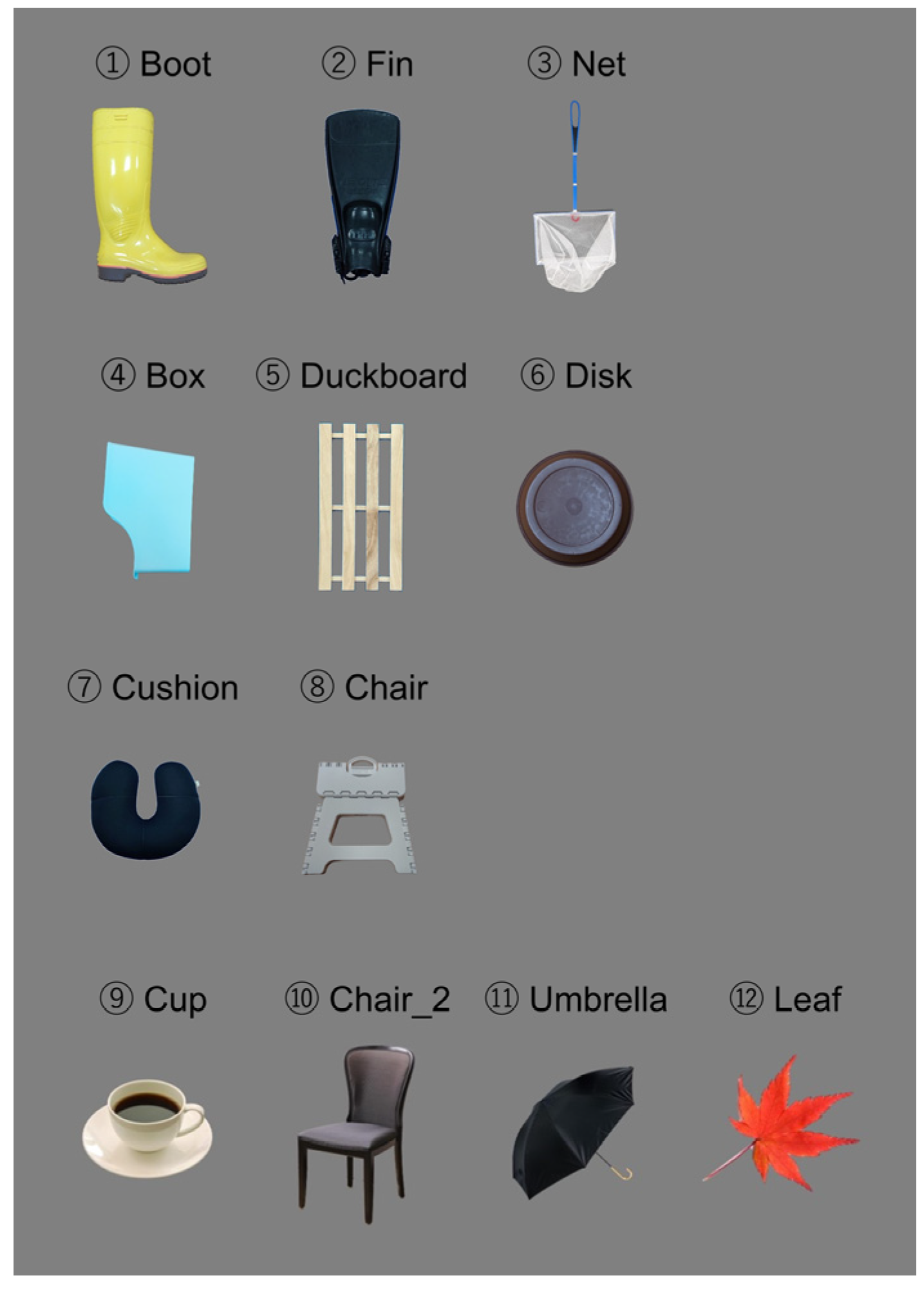
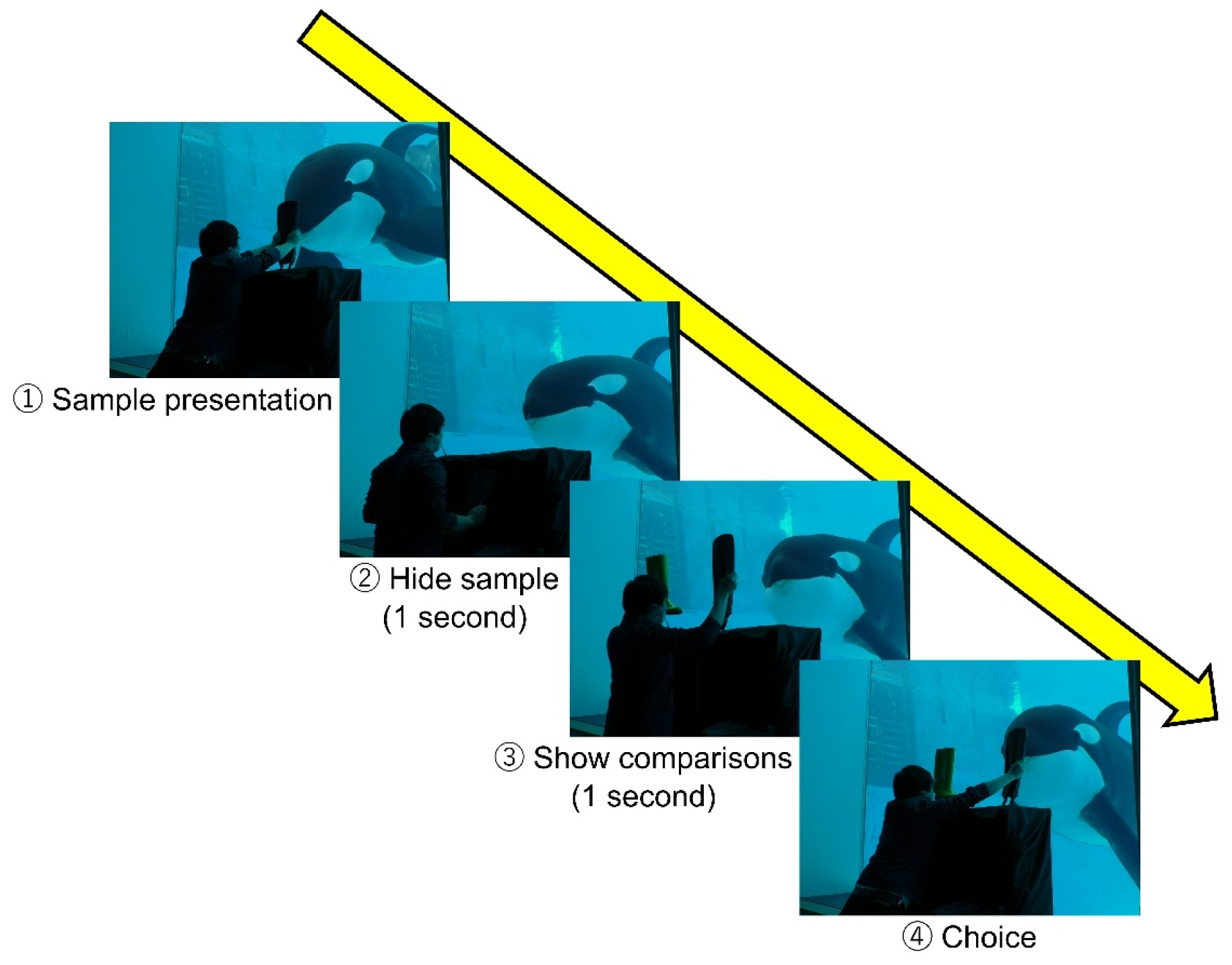
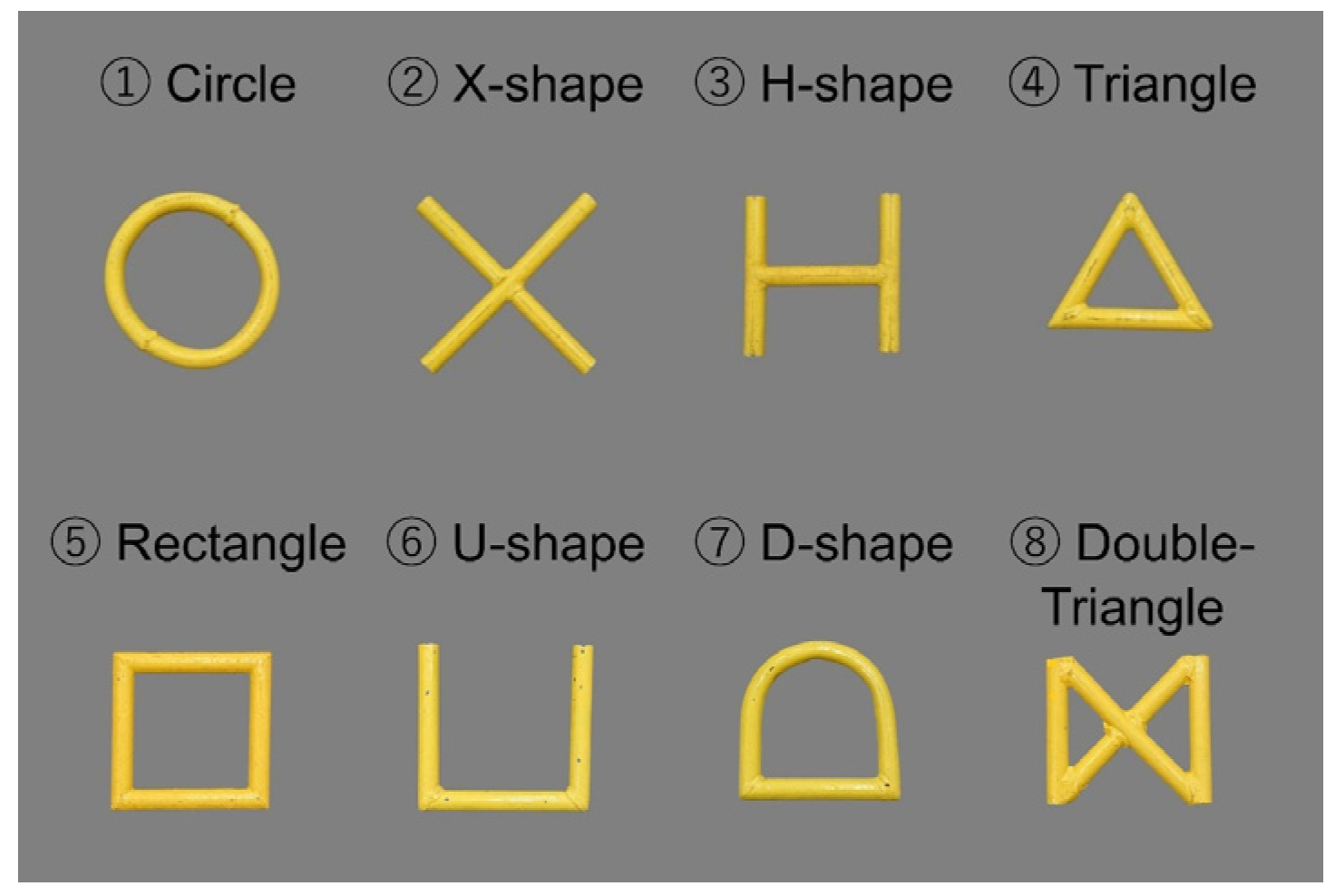
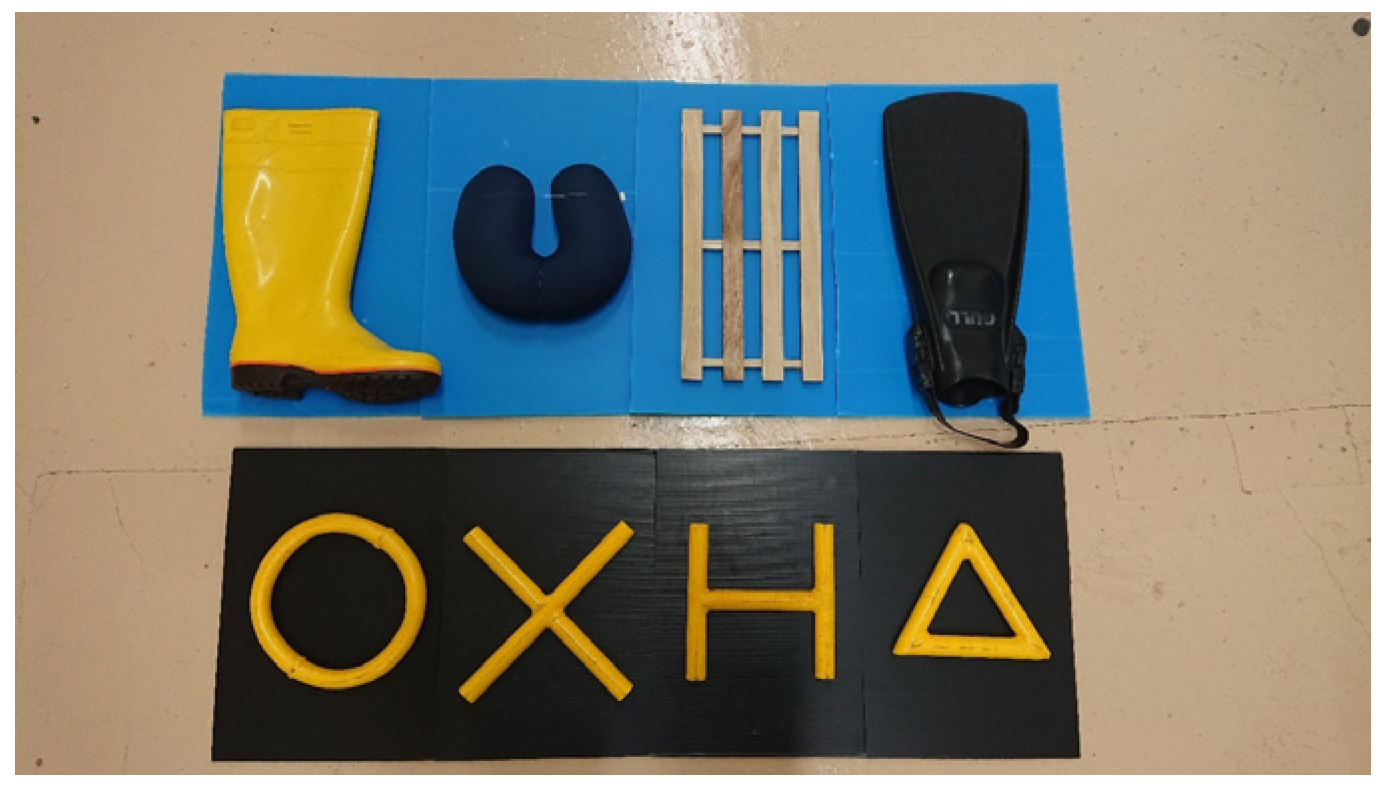
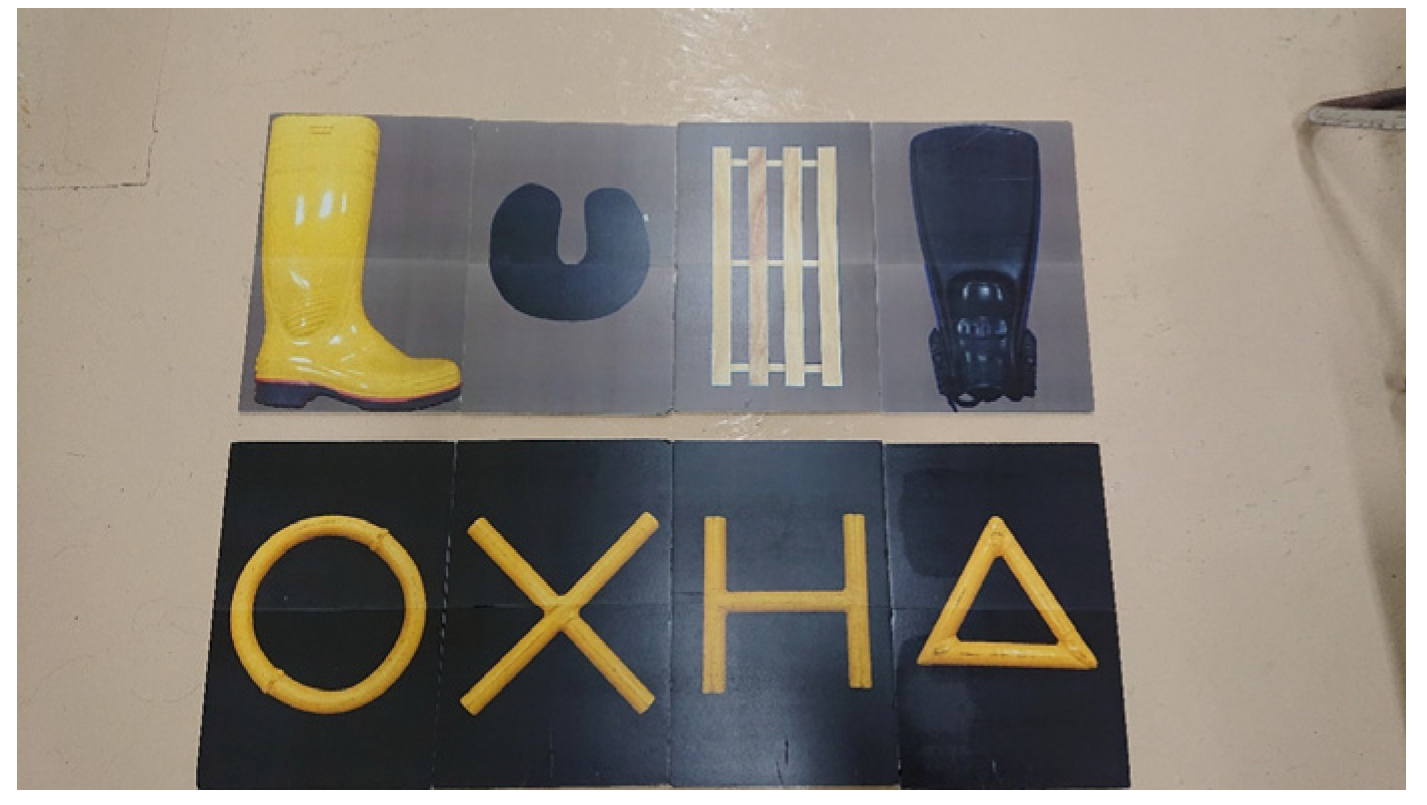
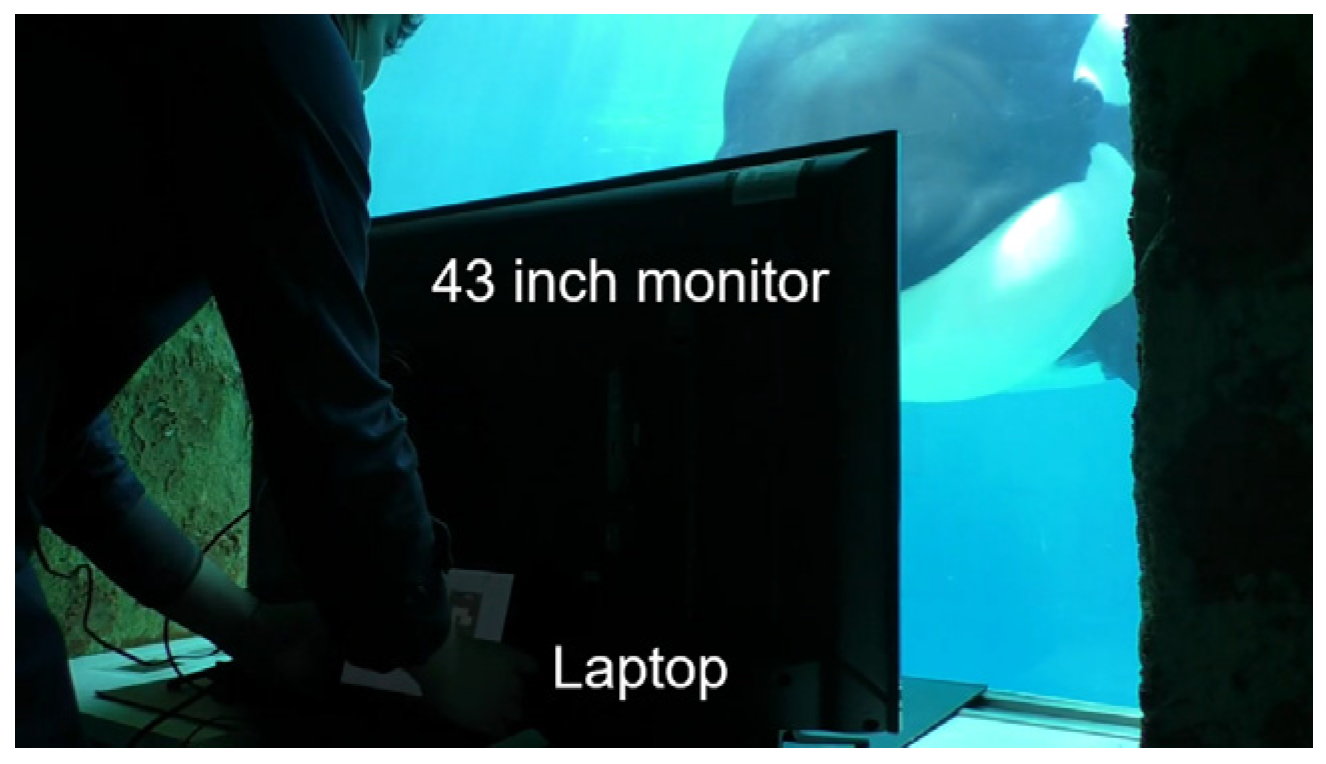


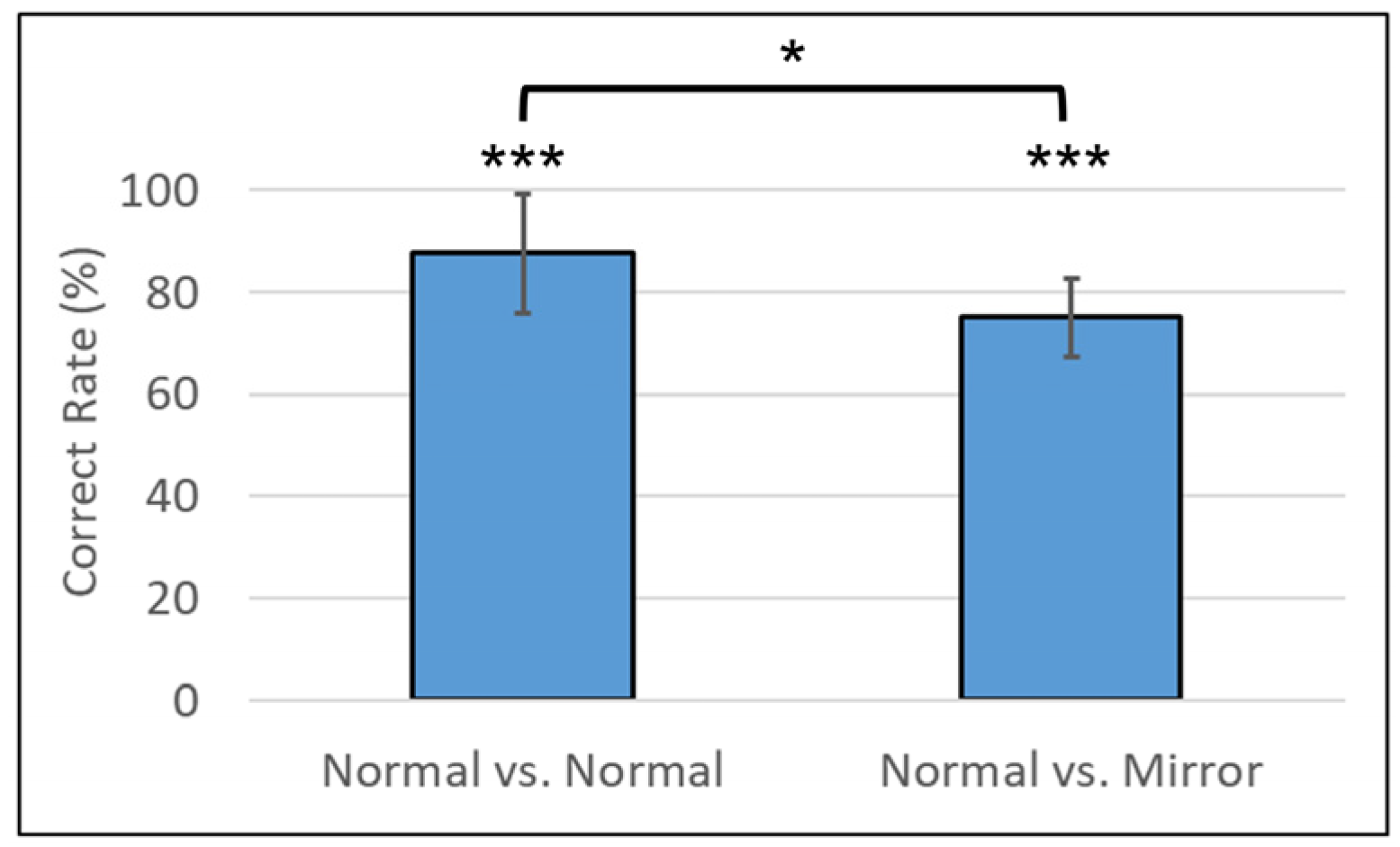
| Normal vs. Normal | Incorrect Image | Total | Normal vs. Mirror | |||||
| A | B | C | D | |||||
| Correct Image | A | 88 | 63 | 69 | 73 | A | 69 | |
| B | 100 | 88 | 94 | 94 | B | 69 | ||
| C | 100 | 81 | 81 | 88 | C | 75 | ||
| D | 100 | 94 | 94 | 96 | D | 88 | ||
| Total | 100 | 88 | 81 | 81 | 88 | Total | 75 | |
Disclaimer/Publisher’s Note: The statements, opinions and data contained in all publications are solely those of the individual author(s) and contributor(s) and not of MDPI and/or the editor(s). MDPI and/or the editor(s) disclaim responsibility for any injury to people or property resulting from any ideas, methods, instructions or products referred to in the content. |
© 2024 by the authors. Licensee MDPI, Basel, Switzerland. This article is an open access article distributed under the terms and conditions of the Creative Commons Attribution (CC BY) license (https://creativecommons.org/licenses/by/4.0/).
Share and Cite
Santa, A.; Kanda, K.; Kako, T.; Miyajima, M.; Adachi, I. Matching-to-Sample Task Training of a Killer Whale (Orcinus orca). Animals 2024, 14, 821. https://doi.org/10.3390/ani14060821
Santa A, Kanda K, Kako T, Miyajima M, Adachi I. Matching-to-Sample Task Training of a Killer Whale (Orcinus orca). Animals. 2024; 14(6):821. https://doi.org/10.3390/ani14060821
Chicago/Turabian StyleSanta, Ayumu, Koji Kanda, Tomoya Kako, Momoko Miyajima, and Ikuma Adachi. 2024. "Matching-to-Sample Task Training of a Killer Whale (Orcinus orca)" Animals 14, no. 6: 821. https://doi.org/10.3390/ani14060821
APA StyleSanta, A., Kanda, K., Kako, T., Miyajima, M., & Adachi, I. (2024). Matching-to-Sample Task Training of a Killer Whale (Orcinus orca). Animals, 14(6), 821. https://doi.org/10.3390/ani14060821





